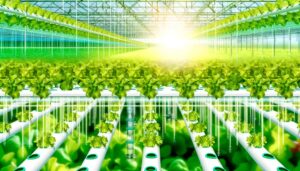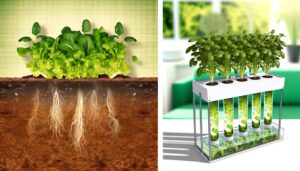What Is the Best Fertilizer for Hydroponics
In hydroponics, the best fertilizer provides a balanced mix of essential macronutrients (N-P-K) and micronutrients, tailored to the plant's growth stage. We recommend using a reliable liquid fertilizer for ease of application and precision, ensuring that solutions include nitrogen, phosphorus, potassium, as well as calcium, magnesium, and essential trace elements like iron and zinc.
Maintaining an ideal pH between 5.5 and 6.5 is important for nutrient uptake. Organic options support sustainability, though synthetic formulations offer more consistent nutrient delivery.
For thorough strategies to maximize your hydroponic success, dive further into the various considerations and techniques we discuss.

Key Takeaways
- Ensure balanced N-P-K ratios tailored to specific growth stages for optimal plant health.
- Include essential micronutrients like Iron, Manganese, and Zinc for complete nutrient profiles.
- Choose liquid fertilizers for ease of use and precise nutrient control.
- Select organic fertilizers for sustainable practices or synthetic for consistent nutrient delivery.
Understanding Hydroponic Nutrients

Understanding hydroponic nutrients involves comprehending the essential macro and micronutrients that plants require for ideal growth in a soil-free environment.
We need to guarantee our nutrient solutions provide nitrogen, phosphorus, and potassium (N-P-K) in balanced ratios. Additionally, secondary nutrients like calcium, magnesium, and sulfur are vital for robust plant development.
Let's not overlook trace elements such as iron, manganese, zinc, copper, molybdenum, boron, and chlorine, which, though required in minute quantities, play significant roles in enzymatic functions and overall plant health.
Liquid Vs. Dry Fertilizers
When comparing liquid and dry fertilizers, we should examine ease of application and nutrient concentration.
Liquid fertilizers provide immediate nutrient availability but can be more cumbersome to measure and mix accurately.
On the other hand, dry fertilizers offer precise control over nutrient ratios but may require more effort to dissolve and distribute evenly.
Ease of Application
Why do we often prefer liquid fertilizers over dry ones for hydroponic systems?
Liquid fertilizers offer greater ease of application. We simply measure, dilute, and add them directly to the reservoir. This precision reduces the risk of nutrient imbalances and guarantees consistent delivery to our plants.
With dry fertilizers, we face the added steps of dissolving and mixing them thoroughly, which can be time-consuming and less exact.
Furthermore, liquid fertilizers integrate seamlessly with automated systems, enhancing efficiency and innovation in nutrient management. Their solubility and ready-to-use nature align with our need for precision in hydroponics, minimizing human error and optimizing plant health.
Consequently, for streamlined operations, liquid fertilizers often emerge as the superior choice.
Nutrient Concentration
While liquid fertilizers offer ease of application, their nutrient concentration often differs markedly from that of dry fertilizers, impacting how we manage and optimize plant nutrition in hydroponic systems.
Liquid fertilizers typically have lower nutrient concentrations, requiring larger volumes to deliver the same nutrient load as their dry counterparts. This can be less efficient and more costly for large-scale operations.
In contrast, dry fertilizers provide higher nutrient concentrations, enabling us to fine-tune nutrient solutions with greater precision. However, they demand careful mixing and thorough dissolution to avoid nutrient imbalances.
When we consider the balance between ease of use and nutrient efficiency, understanding the distinct characteristics of both liquid and dry fertilizers allows us to make informed decisions that enhance hydroponic productivity.
Organic Vs. Synthetic Options

Choosing between organic and synthetic fertilizers for hydroponics hinges on understanding their distinct nutrient delivery mechanisms and environmental impacts.
Organic fertilizers derive from natural sources, promoting sustainable practices and enhancing microbial activity in the nutrient solution. However, they often require more frequent monitoring due to their variable nutrient release rates.
Synthetic fertilizers, on the other hand, offer precise nutrient formulations, ensuring consistent delivery of essential elements. This precision can lead to optimized growth rates and higher yields. Yet, the environmental footprint of synthetic options, including chemical runoff, can't be overlooked.
In our quest for innovation, we must weigh the benefits of organic sustainability against the efficiency of synthetics. This balance is vital for advancing hydroponic systems that are both productive and environmentally responsible.
Essential Nutrients for Plants
Understanding the balance between organic and synthetic fertilizers naturally leads us to examine the specific nutrients plants need to thrive in hydroponic systems.
We must guarantee that plants receive a precise combination of essential nutrients to achieve ideal growth and productivity. These nutrients include both macronutrients and micronutrients, each playing a critical role in various physiological processes.
For instance, nitrogen, phosphorus, and potassium are fundamental for growth, energy transfer, and overall health. Meanwhile, micronutrients like iron, manganese, and zinc, though required in smaller quantities, are crucial for enzyme function and chlorophyll production.
Macronutrients Breakdown

Macronutrients, including nitrogen, phosphorus, and potassium, form the cornerstone of plant nutrition in hydroponic systems. These elements, often referred to as N-P-K, each serve distinct roles.
Nitrogen fuels vegetative growth and protein synthesis, making it essential for leafy greens. Phosphorus is crucial for energy transfer and root development, which is necessary for budding and flowering plants. Potassium regulates water uptake and enzyme activation, enhancing overall plant resilience and disease resistance.
In hydroponics, achieving the right N-P-K ratio is significant. We must tailor this ratio to the specific growth stage of our plants. For example, higher nitrogen concentrations benefit early growth stages, while increased phosphorus and potassium support flowering and fruiting.
Precision in macronutrient management guarantees optimal plant health and yield.
Micronutrients Importance
When discussing micronutrients, we recognize their vital role in plant health and development.
These trace elements, though needed in smaller amounts than macronutrients, are essential for various physiological processes.
Without adequate micronutrients, plants exhibit deficiency symptoms that can severely impact growth and yield.
Essential Plant Nutrients
Though often overshadowed by macronutrients, micronutrients play an essential role in the ideal growth and development of plants in hydroponic systems. These trace elements are critical for various physiological functions and biochemical processes.
Let's consider the essential micronutrients:
- Iron (Fe): Important for chlorophyll synthesis and overall plant respiration.
- Manganese (Mn): Crucial for photosynthesis and nitrogen assimilation.
- Zinc (Zn): Essential for enzyme function and protein synthesis.
- Copper (Cu): Important for reproductive growth and cellular metabolism.
Neglecting these can stunt growth and compromise plant health. Ensuring a balanced supply of these micronutrients can greatly enhance plant vitality and yield.
Deficiency Symptoms
Identifying deficiency symptoms in hydroponic plants is essential because micronutrient imbalances can severely impair physiological functions and reduce overall productivity. Let's explore some common deficiency symptoms and their corresponding micronutrients.
| Micronutrient | Deficiency Symptoms |
|---|---|
| Iron (Fe) | Chlorosis in young leaves |
| Zinc (Zn) | Stunted growth, distorted leaves |
| Manganese (Mn) | Interveinal chlorosis in old leaves |
| Copper (Cu) | Wilting, leaf tip necrosis |
| Boron (B) | Brittle stems, poor flowering |
We must monitor these signs closely. Innovative hydroponic systems rely on precise nutrient delivery, and understanding these deficiency symptoms allows us to tweak nutrient solutions effectively. Addressing deficiencies promptly guarantees our plants thrive, maximizing yield and quality.
Ph Levels and Fertilizers

Maintaining ideal pH levels is essential for guaranteeing that hydroponic fertilizers are effectively utilized by plants and nutrients remain bioavailable. We need to monitor and adjust pH levels regularly to optimize nutrient uptake.
Here's a precise approach:
- Test Frequently: Use a reliable pH meter to check levels daily.
- Adjust Accordingly: Use pH up or pH down solutions to maintain levels between 5.5 and 6.5.
- Monitor Nutrient Solution: Guarantee nutrient solution consistency as pH can fluctuate with nutrient concentration changes.
- Calibrate Instruments: Regularly calibrate pH meters to maintain accuracy.
Choosing the Right Formula
Selecting the ideal hydroponic fertilizer formula requires analyzing plant-specific nutrient needs and growth stages.
We must consider macronutrients like nitrogen, phosphorus, and potassium, as well as essential micronutrients such as iron, manganese, and zinc. Precision is key; a balanced formula during the vegetative phase boosts leaf and stem development, while a different ratio enhances flowering and fruiting.
Research supports using tailored nutrient solutions based on detailed growth cycle data. Innovations in hydroponic systems allow us to customize nutrient delivery, ensuring plants receive optimal concentrations.
Mixing and Diluting Fertilizers

To achieve the precise nutrient balance discussed, we must meticulously mix and dilute fertilizers to exact concentrations tailored for hydroponic systems. Precision in this process guarantees prime plant growth and health.
Here's our step-by-step approach:
- Measure Nutrients: Accurately weigh each nutrient component using a digital scale to guarantee exact proportions.
- Dissolve Separately: Dissolve each nutrient in water separately to prevent chemical reactions that can occur when mixed in concentrated forms.
- Combine Solutions: Gradually add each dissolved nutrient solution into the main reservoir, guaranteeing thorough mixing.
- Check pH and EC: Continuously monitor and adjust the pH and Electrical Conductivity (EC) levels to match the specific needs of our plant species.
Common Fertilizer Mistakes
As we explore common fertilizer mistakes, we must address overfeeding nutrient solutions, maintaining incorrect pH balance, and ignoring water quality.
These errors can severely impact plant health and yield in hydroponic systems.
Let's guarantee our practices are precise and research-based to avoid these pitfalls.
Overfeeding Nutrient Solutions
Overfeeding nutrient solutions often leads to nutrient imbalances and plant stress, undermining the efficiency of your hydroponic system. When we add too much fertilizer, plants can't absorb nutrients effectively, leading to deficiencies or toxicities. To avoid this, we must carefully monitor and adjust our nutrient solutions.
Here are four key practices:
- Measure Electrical Conductivity (EC): Regularly check EC levels to verify nutrient concentration stays within ideal ranges.
- Adhere to Manufacturer Guidelines: Follow recommended dosages to avoid overloading the system.
- Monitor Plant Responses: Observe plants for signs of nutrient stress, such as discoloration or stunted growth.
- Perform Regular Water Changes: This helps prevent the buildup of excess nutrients and maintains solution balance.
Precision in these practices guarantees our hydroponic systems thrive.
Incorrect Ph Balance
Maintaining an ideal pH balance is essential for nutrient uptake in hydroponic systems, and even slight deviations can result in significant plant health issues. We need to be precise when monitoring pH levels, typically aiming for a range of 5.5 to 6.5. Incorrect pH balance can lead to nutrient lockout, where plants can't absorb essential nutrients, stunting growth and causing deficiencies. To avoid this, we should regularly test and adjust our pH levels using reliable meters and pH adjusters.
Here's a quick reference table for common pH-related symptoms:
| pH Level | Symptoms | Solution |
|---|---|---|
| < 5.5 | Yellowing leaves | Use pH up solution |
| 5.5-6.5 | Best growth | Maintain current pH |
| > 6.5 | Leaf tip burn | Use pH down solution |
| < 4.5 | Severe nutrient lockout | Immediate pH adjustment |
| > 7.0 | Alkaline stress | Adjust to 5.5-6.5 |
Ignoring Water Quality
Overlooking water quality can undermine the effectiveness of any hydroponic fertilizer regimen, leading to nutrient imbalances and poor plant health. We must guarantee our water source is ideal to avoid issues that impede growth.
Let's consider four vital factors:
- pH Levels: Water pH affects nutrient availability. Regularly measure and adjust to maintain a range of 5.5-6.5.
- EC (Electrical Conductivity): Indicates the total dissolved salts in water. Ideal levels are between 1.2-2.0 mS/cm.
- Contaminants: Heavy metals and chlorine can harm plants. Use filters or dechlorination techniques.
- Water Source: Tap, rain, and RO (reverse osmosis) water each have unique properties. Choose the best fit for your system.
Conclusion
In hydroponics, selecting the best fertilizer means understanding nutrients, balancing macronutrients, and adjusting pH levels.
We need to take into account liquid versus dry forms, and organic versus synthetic options.
Precision in mixing and diluting fertilizers is essential to avoid common mistakes.
By choosing the right formula, monitoring our plants' needs, and maintaining ideal conditions, we can achieve robust growth and high yields.
Let's harness our expertise, apply research insights, and guarantee our hydroponic systems thrive.






